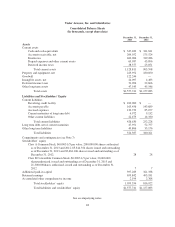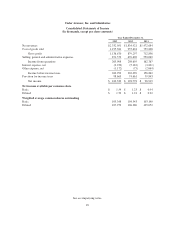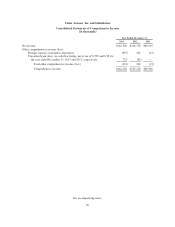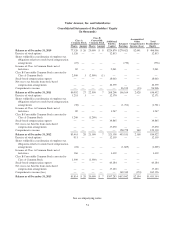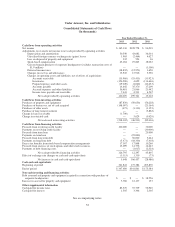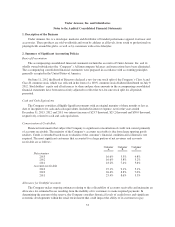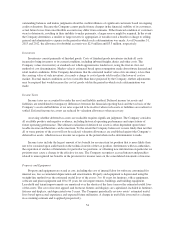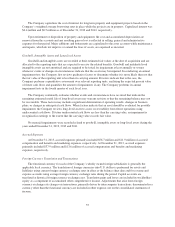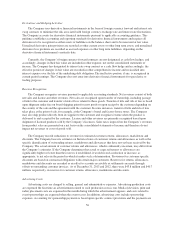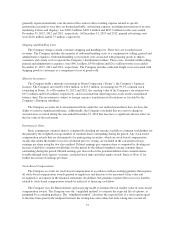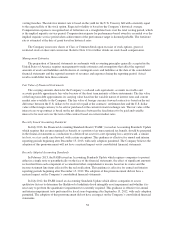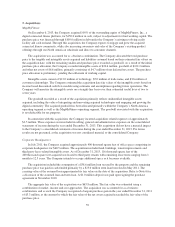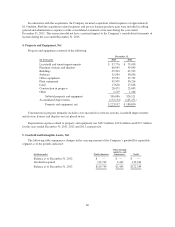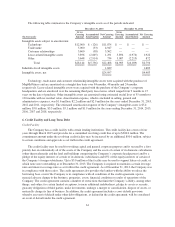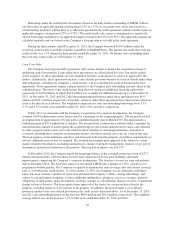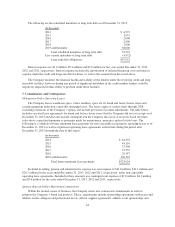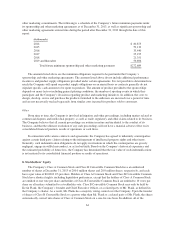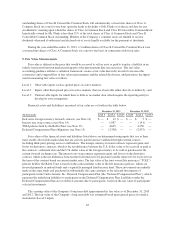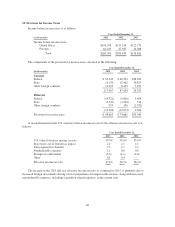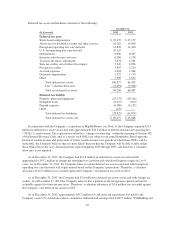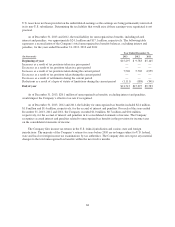Under Armour 2013 Annual Report Download - page 68
Download and view the complete annual report
Please find page 68 of the 2013 Under Armour annual report below. You can navigate through the pages in the report by either clicking on the pages listed below, or by using the keyword search tool below to find specific information within the annual report.vesting tranches. The risk free interest rate is based on the yield for the U.S. Treasury bill with a maturity equal
to the expected life of the stock option. Expected volatility is based on the Company’s historical average.
Compensation expense is recognized net of forfeitures on a straight-line basis over the total vesting period, which
is the implied requisite service period. Compensation expense for performance-based awards is recorded over the
implied requisite service period when achievement of the performance target is deemed probable. The forfeiture
rate is estimated at the date of grant based on historical rates.
The Company issues new shares of Class A Common Stock upon exercise of stock options, grant of
restricted stock or share unit conversion. Refer to Note 12 for further details on stock-based compensation.
Management Estimates
The preparation of financial statements in conformity with accounting principles generally accepted in the
United States of America requires management to make estimates and assumptions that affect the reported
amounts of assets and liabilities and disclosure of contingent assets and liabilities at the date of the consolidated
financial statements and the reported amounts of revenues and expenses during the reporting period. Actual
results could differ from these estimates.
Fair Value of Financial Instruments
The carrying amounts shown for the Company’s cash and cash equivalents, accounts receivable and
accounts payable approximate fair value because of the short term maturity of those instruments. The fair value
of the long term debt approximates its carrying value based on the variable nature of interest rates and current
market rates available to the Company. The fair value of foreign currency forward contracts is based on the net
difference between the U.S. dollars to be received or paid at the contracts’ settlement date and the U.S. dollar
value of the foreign currency to be sold or purchased at the current forward exchange rate. The fair value of the
interest rate swap contract is based on the net difference between the fixed interest to be paid and variable
interest to be received over the term of the contract based on current market rates.
Recently Issued Accounting Standards
In July 2013, the Financial Accounting Standards Board (“FASB”) issued an Accounting Standards Update
which requires that an unrecognized tax benefit, or a portion of an unrecognized tax benefit, should be presented
in the financial statements as a reduction to a deferred tax asset for a net operating loss carryforward, a similar
tax loss, or a tax credit carryforward, with certain exceptions. This guidance is effective for annual and interim
reporting periods beginning after December 15, 2013, with early adoption permitted. The Company believes the
adoption of this pronouncement will not have a material impact on its consolidated financial statements.
Recently Adopted Accounting Standards
In February 2013, the FASB issued an Accounting Standards Update which requires companies to present
either in a single note or parenthetically on the face of the financial statements, the effect of significant amounts
reclassified from each component of accumulated other comprehensive income based on its source and the
income statement line items affected by the reclassification. This guidance is effective for annual and interim
reporting periods beginning after December 15, 2012. The adoption of this pronouncement did not have a
material impact on the Company’s consolidated financial statements.
In July 2012, the FASB issued an Accounting Standards Update which allows companies to assess
qualitative factors to determine the likelihood of indefinite-lived intangible asset impairment and whether it is
necessary to perform the quantitative impairment test currently required. This guidance is effective for annual
and interim impairment tests performed for fiscal years beginning after September 15, 2012, with early adoption
permitted. The adoption of this pronouncement did not have an impact on the Company’s consolidated financial
statements.
58


